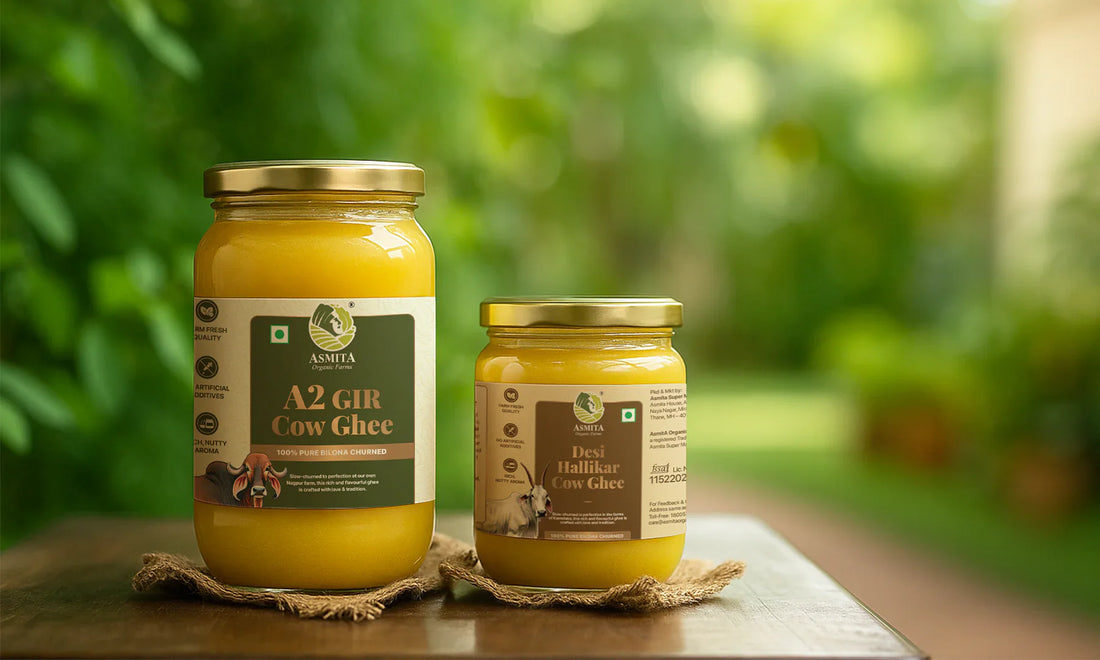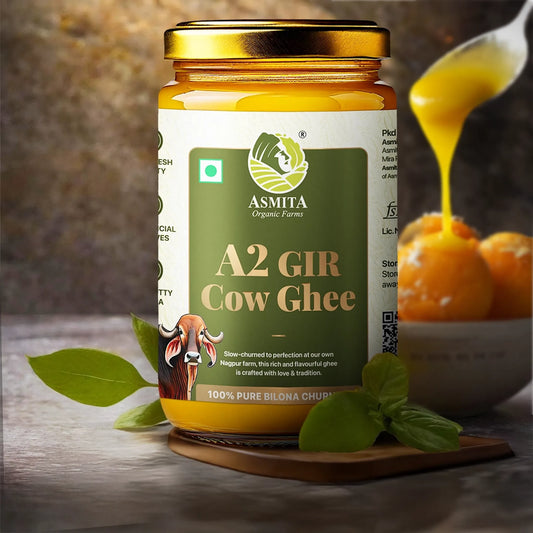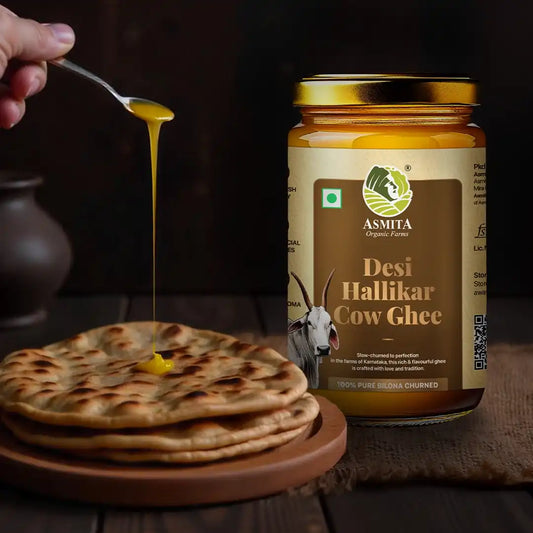Ghee Nutritional Value: Facts, Benefits & Daily Use
5 min read
Ghee has been a staple in Indian kitchens for generations and continues to be appreciated today for reasons that extend beyond tradition. While some view it as a simple cooking fat, it carries a wide range of nutrients and health-promoting properties.
You might have grown up seeing it on rotis, in dal, or added to khichdi, but there’s so much more to this golden spoonful. This blog breaks down the ghee nutritional value, its key benefits, how it supports your daily routine, and why choosing high-quality ghee makes a big difference.
Table of Contents
1. What’s in a Spoon of Ghee?
2. Key Nutrients in Ghee
3. Health Benefits of Ghee
4. Ghee in Ayurveda and Digestion
5. Ghee vs Other Cooking Fats
6. How Much Ghee is Good Daily
7. Bottom Line
What’s in a Spoon of Ghee?
When we talk about the ghee nutritional value, it helps to break it down into what you’re actually getting in each serving. One tablespoon, or around 15 ml, is a common daily portion for most people.
This small amount carries a good balance of healthy fats and essential nutrients. If you’ve ever wondered about ghee calories, here’s a quick look at what’s inside AOF’s Gir Cow Ghee and Halikar Cow Ghee:
|
Nutrient |
Gir Cow Ghee (per 100 ml) |
Hallikar Cow Ghee (per 100 ml) |
|
Energy (kcal) |
898 |
898 |
|
Protein (g) |
0 |
0 |
|
Carbohydrate (g) |
0 |
0 |
|
Total Sugars (g) |
0 |
0 |
|
Added Sugars (g) |
0 |
0 |
|
Total Fat (g) |
99.77 |
99.8 |
|
Saturated Fat (g) |
63.92 |
60.47 |
|
Trans Fat (g) |
0 |
0 |
|
Omega 3 Fatty Acids (g) |
— |
0 |
|
Omega 6 Fatty Acids (g) |
3.11 |
3.92 |
|
Monounsaturated Fats (g) |
32.97 |
35.41 |
|
Polyunsaturated Fats (g) |
3.11 |
3.91 |
|
Cholesterol (mg) |
253.4 |
231 |
|
Sodium (mg) |
2.35 |
0 |
|
Vitamin A (mg) |
0.82 |
— |
Key Nutrients in Ghee
Ghee is a rich fat source that carries fat-soluble vitamins like A, D, E, and K. These nutrients support immunity, eye health, bone strength, and skin repair. Ghee is also naturally free from lactose and casein, making it suitable for those with dairy sensitivity.
One of the most notable elements in high-quality ghee is Conjugated Linoleic Acid (CLA), which has been linked to various health advantages, including improved metabolism and reduced inflammation. In addition to its nutrient density, the ghee fat content provides the body with essential fatty acids that are important for energy and cellular function.
When you opt for an A2 ghee like the one produced from well-raised, grass-fed Gir or Hallikar cows at AOF, you’re choosing a product that is known to have a higher nutritional profile compared to regular ghee, thanks to its pure A2 protein and pasture-raised sourcing. This ensures that the vitamins in ghee are absorbed efficiently and used effectively by the body.
Health Benefits of Ghee
Before you think of ghee as just another fat, it’s worth knowing that it does more than add flavour to food. Let’s take a look at some of the key benefits:
- Helps with Weight Management: Ghee contains Conjugated Linoleic Acid (CLA), which has been linked to reduced body fat and better muscle retention. Including a small amount of ghee for weight loss in your meals can help you feel full for longer, reducing the need for frequent snacking.
- Supports Long-Lasting Energy: The healthy fats in ghee break down slowly, giving you sustained energy throughout the day. This makes it a solid option for those who need mental focus or physical stamina. Whether you're a student preparing for exams or a sportsperson training regularly, ghee for energy can be a natural solution.
- Good for Heart Health: When taken in moderation, ghee supports cardiovascular function. Though it contains saturated fat, it plays an important role in hormone balance and brain performance. AOF’s Desi Hallikar Cow Ghee is rich in antioxidants, which help reduce the impact of free radicals in the body.
- Boosts Nutrient Absorption: Ghee helps the body absorb fat-soluble vitamins like A, D, E, and K more efficiently. These vitamins support vision, bone health, skin repair, and immunity.
- Natural Anti-Inflammatory Properties: Traditional diets and Ayurvedic texts credit ghee for its ability to reduce inflammation. It’s often used during recovery from illness or physical strain due to its gentle and soothing effect on internal tissues.
Ghee in Ayurveda and Digestion
According to Ayurveda, ghee is considered one of the most nourishing substances for both the body and the mind. It is used to balance the body's internal energies and is known for its ability to enhance the absorption of nutrients in food.
In Ayurvedic practices, ghee is often used as a carrier for herbs and is believed to penetrate deep into the tissues, bringing nourishment and assisting with detoxification. It is gentle on the stomach and supports the lining of the digestive tract.
The type of ghee used in Ayurvedic routines matters significantly. A2 ghee nutrition is especially favoured in traditional wellness approaches for its purity, digestibility, and nutritional richness.
AsmitA Organic Farms’ A2 Hallikar Ghee and Gir Cow Ghee are ideal for these purposes, as they are free from artificial additives and prepared traditionally to maintain their therapeutic quality.
Ghee vs Other Cooking Fats
When comparing ghee vs butter, olive oil, or vegetable oil, several things stand out. Ghee has a higher smoke point (252°C), which means it does not break down easily during cooking. This makes it a safer option for sautéing, frying, and roasting.
Ghee also offers a richer nutrient profile. While butter contains lactose and casein, ghee has them removed during the clarification process. Vegetable oils, on the other hand, often contain polyunsaturated fats that may turn harmful when exposed to high heat.
The difference becomes even more noticeable when you choose traditionally made A2 ghee. AOF’s A2 ghee retains its nutritional potency, flavour, and texture due to the slow churning method. This makes it more stable and digestible compared to most store-bought cooking fats.
How Much Ghee is Good Daily?
Ghee is nutritious, but it is still calorie-dense. For most people, one to two tablespoons (15–30 ml) of ghee per day is suitable.
Those with active lifestyles, such as athletes or individuals on a low-carb diet, may benefit from slightly more. It is important to observe your body’s response and adjust accordingly.
Balance remains key. When ghee is used along with whole grains, lentils, vegetables, and protein sources, it supports digestion and the absorption of fat-soluble nutrients.
Premium ghee, such as the Hallikar Cow Ghee and Gir Cow Ghee by AOF, is ideal for daily use, especially when used as a topping on rice, in rotis, or stirred into warm beverages like turmeric milk.
Bottom Line
Ghee has earned its reputation as a wholesome fat that brings both flavour and function into your meals. From boosting energy levels to supporting digestion, strengthening immunity, and offering essential vitamins, the ghee nutritional value makes it a smart addition to your routine.
Choosing the right kind of ghee is just as important as including it in your diet. AOF's A2 Ghee, made from the milk of native Gir and Hallikar cows and processed through the traditional bilona method, ensures that what you’re consuming is rich, pure, and full of nutrients.
Order your jar today and experience how the right ghee can transform both your cooking and your well-being.












